Beef Cattle
1/88
There's no tags or description
Looks like no tags are added yet.
Name | Mastery | Learn | Test | Matching | Spaced |
|---|
No study sessions yet.
89 Terms
What is an intact male called?
Bull
What is a castrated male called?
steer
What is a female pre caving called?
heifer
What is a female post calving called?
Cow
What is a young cow called?
calf
What is the act of parturition called?
calving
What is a group of cattle called?
Herd
What is the scientific term for cows?
Bovine
What is the single largest money-generating commodity in all of agriculture?
beef industry
What is the gross annual income from beef in the US?
45 billion
How much do beef products account for cash receipts out of all agricultural receipts?
18%
How much do beef accounts for animal agriculture’s share of total farm cash receipts?
39%
How much does the US have of word’s cattle and how much beef/veal produced?
6% of cattle but 18% of beef/veal
Who are the top two producing beef countries in the world?
US and Brazil
What percent of beef operations have less than 50 head of cattle?
30%
What percent of herds have less than 100 cows?
90%
What is the purpose of beef cattle?
to make use of resources that would otherwise go to waste predominantly grass - conversion of roughage is chief contribution of beef cattle to welfare of humans
What are the top five beef cattle states?
Texas, Nebraska, Kansas, California, Oklahoma
What are the stats about Louisiana beef industry?
cow-calf state, seedstock operations, stocker operations, 790,000 cows/calves on 13,600 farms valued at 249 million
What are the seven phases/segments of the beef industry?
seedstock, cow-calf, stocker, feedlot, packer/processor, retail, consumer
What is the general structure of the beef industry?
change ownership when moving from phases, distinct regionality with specialization
What are seedstock productions?
only segment that does not produce animals whose primary use is for meat consumption, primary goal is to produce breeding stock, greatest demand from segment is bulls
What are cow-calf operations?
represent first phase of producing animals whose primary use is for meat, 6-10 month old crossbred calves weighing 300-700lbs is the product of this segment, calves usually sold at weaning to feedlot or stocker, main goal is produce heaviest calves with least cost
What are stocker operations?
yearling/stocker operators grow calves to heavier weights on low priced forage before they enter feedlot, typically purchase from cow-calf and grow for specific season, receive various health procedures like vaccines deworming and bunk broke - value added
What are feedlot operations?
aka finishing phase, normally go to lot at 1 yr old, 600-850lb cattle finished to market weight of 900-1400lb, usually stay for 60-200 days, most are fed grain
What are packer operations?
harvest finished cattle from feedlots, break down carcasses into subprimal cuts
What are retailer operations?
purchases from packers/processors, break down subprimal cuts to retail cuts, present product to consumer
What is the consumer phase?
behavior and purchasing trends influence subsequent decisions made by every other segment
What is a breed?
race of animals within species, typically of common origin and similar identifying characteristics, have strong and weak points, no one perfect breed
What is a breed association?
organization that defines animal type for breed, provides genetic base material for breeders, 50-80 associations in US but 10 major
What are the two major classes of beef catttle?
Bos taurus or Bos indicus
What are the considerations when selecting a breed?
environmental compatibility and market demand for offspring
What are the English (maternal) breeds?
Angus, Red Angus, Hereford, Shorthorn
What are the Continental (terminal) breeds?
Charolais, Gelbvieh, Limousin, Simmental
What are the Heat Tolerant breeds?
Brahman, Senepol, Longhorn
What are the Composite breeds?
Brangus, Braford, Beefmaster, Santa Gertrudis
What are the advantages and disadvantages of maternal breeds?
adv - good mothering, excellent fertility, early sexual maturity, carcass traits, milking, disadv- light muscled, slow growing, fat carcasses
What are the advantages and disadvantages of terminal breeds?
adv- fast growing, heavily muscled, good feed efficiency disadv - large nutrient demands, high birth weights, large framed, late sexual maturity, lower quality carcasses
What are the advantages and disadvantages of heat tolerant breeds?
adv - disease resistant, parasite resistant, good mothering, longevity, strong survival disadv- temperament (indicus), late sexual maturity, poor carcasses characteristics
What is a composite breed?
breed made up of at least two component breeds designed to retain heterosis in future generations without crossbreeding and maintained as a purebred, has defined proportions
What does an Angus look like?
naturally polled, mostly all black
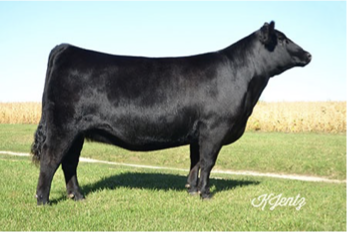
What does a Hereford look like?
down turned horns has polled and non polled lines, white face belly feet and tail big issue is photosensitivity and skin/eye cancer but now breeding red around eyes
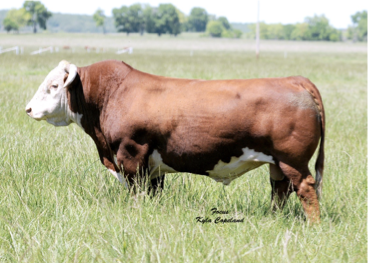
What makes a black baldy?
hereford x angus some have horns it depends because no polled is only male dominant

What does a red angus look like?
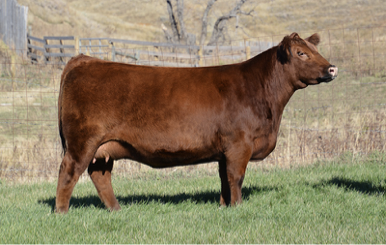
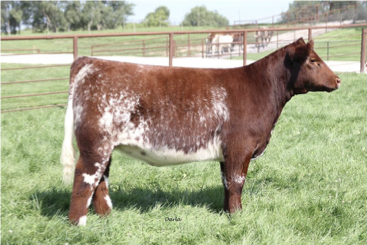
What does a shorthorn look like?
red and white or roan milking or beef breeds
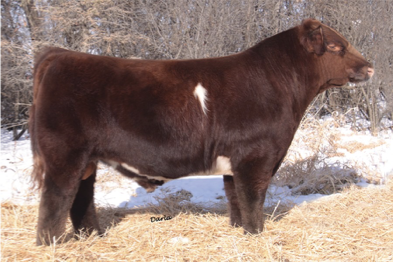
What does a Charolais look like?
from france, mostly solid white very large 1800-2000lb bull
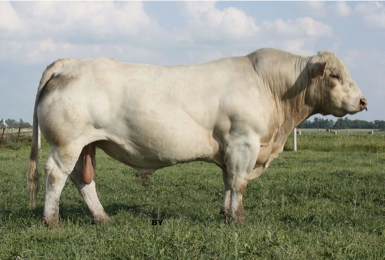
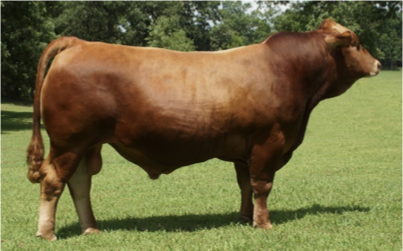
What does the Gelbvieh look like?
from Austria, mahogany or red lighter color on legs and muzzle
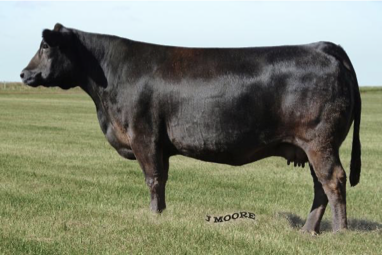
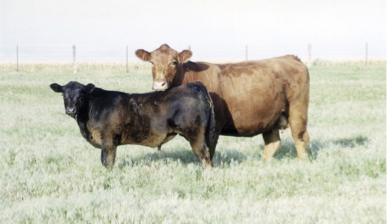
What does the Limousin look like?
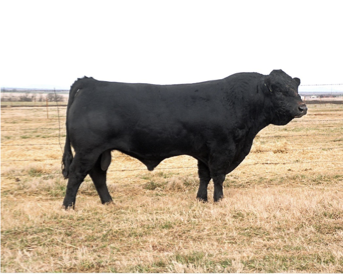
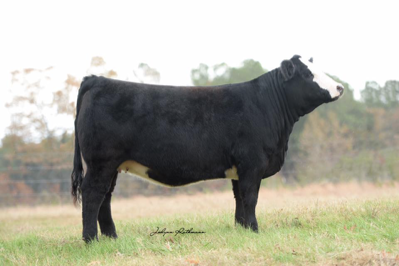
What does the simmental look like?
Austrian red and white old genetics dual purpose US will register individuals with black coat

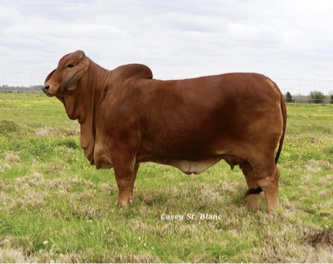
What does the Brahman look like?
Red or Grey red is recessive most likely developed from three indian zebu breeds Gir, Guzerat, and Nelore
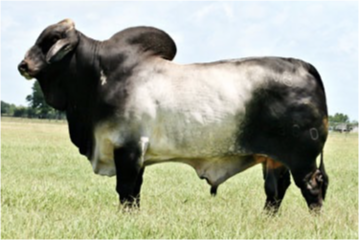
What is the Brahman influence in LA?
north LA is 0-1/4 influence, middle is 1/4-1/2 and coast is 1/2- purebreed
What does the Senepol look like?
island breed short red hair, heat tolerant

What does the Texas Longhorn look like?
only truly native US breed from spanish cattle very long lived mostly pasture ornaments or horns
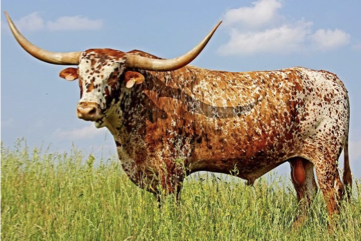
What is a Brangus breed?
born at Ibus research station in LA, 3/8 brahman 5/8 angus
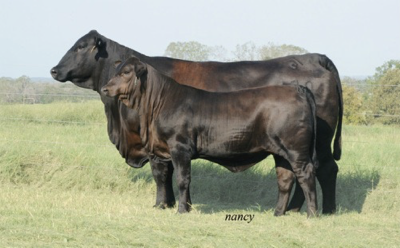
What does Braford look like?
3/8 brahman 5/8 hereford
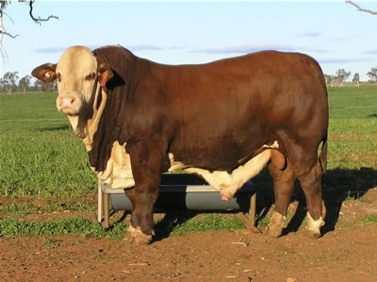
What does Santa Gertrudis look like?
developed in king ranch Texas very large takes a lot of feed money 3/8 brahman 5/8 shorthorn
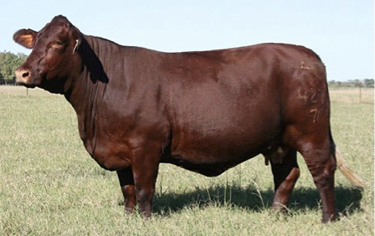
What does beefmaster look like?
¼ hereford, ¼ shorthorn, ½ brahman

What is crossbreeding and its uses?
mixing two breeds used for hybrid vigor to increase performance of offspring compared to parents, and breed complementarity to overall improvement of offspring resulting from different but complimentary biological types
What are the Queens of the Cow Country
F1 female Brahmans they are 50% brahman and 50% other breed have increased milk production and higher fertility wean faster longer productive life used in south
Why is body weight important?
need to know for nutrition, drug dosing, marketing and breeding weight can figure out using scale or formula similar to horses and measuring tape
Why is identification important?
necessary for any type of operation, assist with records theft shared pastures, permanent or temporary like ear tags, RFID tags tattoos branding
What are the nutrient requirements for beef cattle?
they change based on life stage - maintenance gestation or lactation - peaks 45-60 post calving
What is the critical period of cow herd production for nutritional requirements?
from the start of last trimester to when the cow conceives because you need maintenance requirements then also highest milk requirements and highest pregnancy requirement
If there was an 1000lb and 1200lb cow that were both lactating which animal would need more dry matter intake?
1200lb
What is important about Body Condition Score?
Indicators of cow nutrition status, 1-9 with one being emaciated and 9 extremely obese 5-6 ideal, one level is about 80lbs difference on a 1000lb cow, related to pregnancy rate calving weaning daily gain - money
What is the cut of meat taken from the chest?
brisket
What happens if a cow is too thin or fat?
thin - abnormal reproductive cycles, failure to conceive, increased calving interval, increased days to estrus, decreased calf vigor overweight - costly, increased dystocia, impaired mobility, abnormal reproductive cycles, failure to conceive
What is the goal of herd nutrition?
provide adequate nutrition on forages, eat about 2.5% of body weight in DM, supplements may be needed depending on season and hay fed during winter
How do you calculate daily hay needs per cow?
first multiply weight by 2.5% of body weight (taking into account nutritional phase) which gives you DM needed per day then take DM and divide by 88% hay DM to find out number of lbs of hay needed to be fed to meet DM requirements
How do you find the number of bales needed per how?
multiple as fed hay number by 120 days for winter season and then divide that by 850lb per bale to find number of bales but then factor in hay loss percentages by dividing number by percent and then you have real number of bales needed
What are some issues with feeding hay?
storage losses - not covering, rot and feeding losses - stomp on it need a bale feeder not just roll out
What are some important reproductive stats for beef cattle?
reach puberty around 10 months, 21 day estrous cycle, 14-16 estrus (heat), 10-14 hours after standing heat will ovulate, length of gestation is 283 days, cattle breed year round - but not ideal during some seasons, either natural service or AI and can heat synchronize
What are the difference heat synchronization protocols?
one injection of PGf2a, Two injections of PGf2a, MGA and Pgf2a, and Pgf2a and GnRH
Why do we control breeding season?
produces controlled calving season, only breed for 60-90 days so calving season is only 60-90 days, so you can concentrate labor and resources for a shorter amount of time and makes calves more uniform for sale, and similar nutrient requirements so more efficient
What are the different types of breeding programs?
Purebred - seedstock mating animals within same breed, Crossbreeding - commercial operations crossing animals of different breeds, Breed/Calving season - spring calving breed mid april to mid june then calf end january end march, fall calving breed start of january to end of march the calf mid october to start of december
What is important about heifer reproductive managment?
first calf heifers be breed to calve at 2 yrs, breed around 15 months age 60-65% of mature BW, may wait until 36 months to breed but makes profit hard, and be breed 30 days earlier than cows so they can recover before joining herd and reproductive tract recover and stressful
What is important about bull reproductive management?
begin breeding 15 month of age, can breed one female per month of age need breeding soundness exam every season for testicular development semen quality and libido, bull evaluation more important to producer than selecting replacement heifers
What are some diseases that affect reproductive efficiency?
Brucellosis (Bang’s disease) - carried by wild animals not irradicated but controlled can vaccinate against 4-10 months of age, Vibriosis - vaccinate, Leptospirosis - vaccinate, IBR/BVD complex, Trichomoniasis- combo of protozoa in sheath of bull if bull removed females will recover bulls must be culled
What are some important reproductive efficiency things?
conception rate - number of females pregnant/total number of females exposed x 100, calf crop percent - number of calves weaned/number of females exposed x 100, calving interval - time period from when a cow calves this year to when she calves next year - ideal is 12 months
What are the initial signs of calving?
nervousness, cow/heifer goes off feed, alienation, milk let down, swollen vulva, tail kinks
What are the stages of parturition?
Stage 1 - restlessness frequent stand up/laying down not eating usually takes 2-6 hrs to fully dilate, Stage 2 - water sac protrudes and breaks fetus enters birth canal regular intermittent straining once front feet out calf expulsion should happen in 1-2 hrs, Stage 3 - expulsion of placenta and fetal membranes usually 1/2-8 hours membranes not expelled after 12 hrs considered retained
What is dystocia?
difficulty with the calving process, number of factors - presentation of fetus, birth weight, sex of calf, pelvic area of mother, nutrition, gestation length, paternal maternal influence
What is processing calves?
management practices done after birth - ear tagging, record weight, treat naval, castrate
What are the types of castration tools?
emasculatome, emasculator, elastrator, and scalpel but farmers don’t use cause you always shred vas differns not cut
What are the different types of weaning?
fenceline - low stress, spend more time eating gain more weight respond better to vaccines, move pairs to pasture where calves will be few days before separation, need strong fences Weaning nose flaps - low stress form of weaning, Cold turkey weaning - separate dam and calf and eliminate all contact every stressful for everyone
What is preconditioning?
preparing calves for the feedlot, given time to overcome the stresses associated with weaning , weaned for at least 45 days, are bunk water broke and value added procedures, it decreases number sick and death and lowers treatment cost and improved performance and carcass quality
What is important about herd health?
more than a vaccine program, easier to develop if using controlled breeding, no generic program, includes nutrition, parasite control biosecurity vaccination genetics minimizing stress
How can cattle be aged?
other than keeping good records can go by dentition to estimate cattle have 20 temporary teeth and then are replaced by 32 permanent teeth will have 8 incisors eruption is distinct pattern start in middle and then spread out all temp using in by one month but first adult pair around 18-24 then second 24-30 then third 36 and last is 42-48
Why are records important?
key to any successful operation, used to solve problems, keep performance info - birth weight weaning weight yearling weight ADG FE, breeding records - breeding date, sire used, calving date Animal treatment records - withdrawal times, Feed records, and Chemical records - pesticides/chemicals applied to pasture